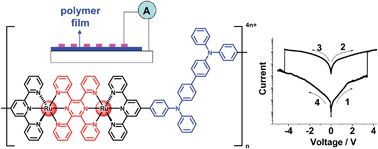Tuning of resistive memory switching in electropolymerized metallopolymeric films†
Abstract
A diruthenium complex capped with two triphenylamine units was polymerized by electrochemical oxidation to afford metallopolymeric films with alternating diruthenium and tetraphenylbenzidine structures. The obtained thin films feature rich redox processes associated with the reduction of the bridging ligands (tetra(pyrid-2-yl)pyrazine) and the oxidation of the tetraphenylbenzidine and diruthenium segments. The sandwiched ITO/polymer film/Al electrical devices show excellent resistive memory switching with a low operational voltage, large ON/OFF current ratio (100–1000), good stability (500 cycles tested), and long retention time. In stark contrast, devices with polymeric films of a related monoruthenium complex show poor memory performance. The mechanism of the field-induced conductivity of the diruthenium polymer film is rationalized by the formation of a charge transfer state, as supported by DFT calculations.


 Please wait while we load your content...
Please wait while we load your content...